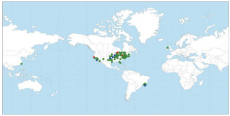Open for Science
Scientists Can Now Manage Research at NERSC and Elsewhere via One Access Point
May 1, 2007

The map shows the locations of more than 50 computing and storage sites that form the Open Science Grid.
More NERSC users can now launch and manage their work at multiple computing sites by going through a centralized grid, thanks to efforts to connect NERSC’s systems to the Open Science Grid (OSG).
The SGI Altix 350 visualization server, named DaVinci, joined the OSG last month, the latest in a long-range plan to connect all NERSC supercomputers to the grid, said Shreyas Cholia, a member of the Open Software and Programming Group at NERSC.
Making NERSC part of the more than 50 sites in the United States, South America and Asia that make up the OSG will save valuable time and reduce headaches for scientists who carry out their research at several computing facilities. Instead of dealing with different authentication processes and software at each site, the scientists can go through the OSG to manage their computing jobs and data files.
“Being part of OSG gives scientists a one-stop interface where they can run and access all of the computing jobs,” Cholia said. Nearly four dozen NERSC users already have registered to use the OSG. Although the PDSF system at NERSC has been part of the OSG for several years, it’s primarily for projects in high energy physics and nuclear science.
Making other NERSC supercomputers available over the OSG has been a priority over the past year. NERSC managers tapped Cholia to work on integrating OSG services and hired Jeff Porter to be part of the OSG team that validates and tests software tools. Bill Kramer, NERSC’s General Manager, chairs the OSG Council.
Connecting NERSC systems to the OSG requires bridging different pieces of software and building a new infrastructure, particularly when some of the NERSC computer architectures are new to the OSG. Cholia is responsible for examining the OSG software stack and figuring out ways to support it, either through using solutions already available or by developing new ones.
Porter, on the other hand, works on making sure the software released by OSG several times a year can be deployed without glitches. He runs validation tests and solicits feedback from selected users who also get to run the new tools over a testbed, or a small grid.
In the next few months, Jacquard, the Opteron cluster at NERSC, will join the OSG. Adding Jacquard will bring parallel computing resources to the OSG and make such resources available for scientists who need to run MPI codes and larger parallel jobs. Cholia and Porter also are evaluating other NERSC systems such as Bassi and Franklin for the grid.
Having NERSC be part of the OSG helps the OSG to fulfill one of its goals— attracting a greater variety of users from different disciplines. NERSC hosts research from a wide-range of scientific communities, including life sciences, material sciences, climate research and chemistry.
NERSC also has set aside computing time specifically for projects carried out over the OSG, part of an effort to attract new research and users.
“We are keeping up with the cutting edge methods of how high-performance computing is done,” Porter said.
Learn more about the Open Science Grid at http://www.opensciencegrid.org.
About NERSC and Berkeley Lab
The National Energy Research Scientific Computing Center (NERSC) is a U.S. Department of Energy Office of Science User Facility that serves as the primary high performance computing center for scientific research sponsored by the Office of Science. Located at Lawrence Berkeley National Laboratory, NERSC serves almost 10,000 scientists at national laboratories and universities researching a wide range of problems in climate, fusion energy, materials science, physics, chemistry, computational biology, and other disciplines. Berkeley Lab is a DOE national laboratory located in Berkeley, California. It conducts unclassified scientific research and is managed by the University of California for the U.S. Department of Energy. »Learn more about computing sciences at Berkeley Lab.







